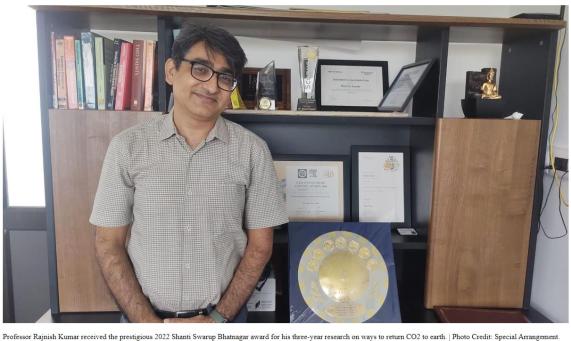
IITM professor bags national award for research on carbon sequestration
- 20th Nov 2023
-
The Hindu
Rajnish Kumar has been working on ways to sequester CO2 from atmosphere
Rajnish Kumar, a faculty member in the chemical engineering department of the Indian Institute of Technology Madras (IITM), who has bagged the Shanti Swarup Bhatnagar award in the field of engineering for the year 2022, has been pursuing research on sequestering carbon dioxide (CO2), a process by which carbon is returned to earth. Prof. Kumar has been working on the project for the last three years and his research got him the award.
CO2 is produced when vehicles use fuel. Industries, especially cement, chemical and synthetic fuel production, emit CO2. While design improvement in vehicles reduced the emission of sulphur and nitrogen oxide gases, the challenge is to capture CO2 from the atmosphere, especially from industries, says Prof. Kumar.
In the pre-industrialisation era, CO2 emission was below 300ppm, but in the last 100 years it has gone up to 420ppm and is predicted to go up to 1000ppm by in the future. "The point is whether 1000ppm will result in change in weather conditions or will there be other changes," he points out.
Currently, India produces 2.8 billion tonnes of CO2 a year, the professor explained. Researchers are trying to find ways to cut CO2 emissions in cement, steel and chemical industries as it is easier than to capture CO2 emitted from vehicles.
The second research challenge scientists are working on is synthesising an inexpensive material to capture the CO2.
"It costs a‚¹4.50 to capture one kg of CO2 from point source today. This means, to produce 1 kilowatt hour of electricity one has to roughly, on an average, produce 1 kg of CO2 by coal. The electricity cost will double just for capturing CO2. The problem arises due to the scale," he explained.
While researchers have found ways to store carbon, the problem is how to store CO2 once it is captured. Then, of course, breaking down CO2 into carbon and oxygen, for which hydrogen is required.
"CO2 was generated because we combusted oxygen to create CO2. But to break down CO2, we again need energy and hydrogen. We do not know yet how to store hydrogen, a low-density gas," he observes.
Planting trees is not a viable solution as even farming consumes water, Prof. Kumar says. A kilo of sugar comes from 3,000 kg of water used to produce the product, he argues. "We are disturbing the equilibrium. The challenge is to educate people and it cannot be achieved overnight; it requires longer period of sustained effort. Can we really turn it around in 10 to 15 years? We must plan for the next 500 years. That is the kind of futuristic thinking we rely on," he concludes.

